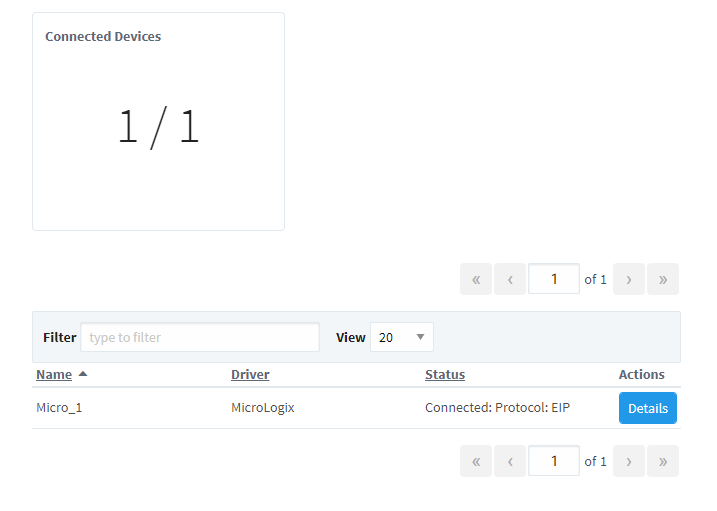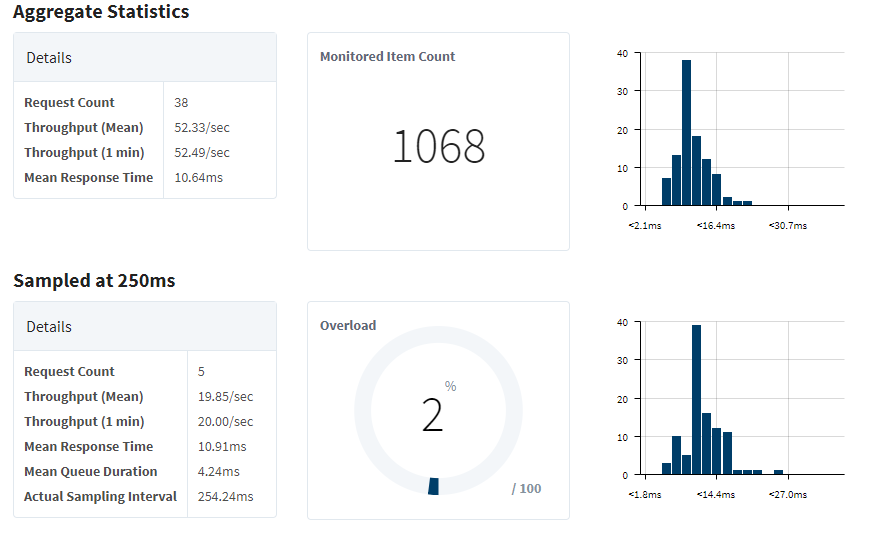Connections - Devices
Devices
The Devices page lists the currently configured OPC UA devices, and lets you know which are connected and which have a faulty connection. From here, you can drill into a device connection to see how many tags Ignition is requesting from the device, along with how often it is requesting them. This information can be used to determine if we are overloading the device with too many requests too quickly, or if we can request more from our device.
Devices Page
The main Devices page lists out all OPC UA devices, as well as how many currently have a valid connection. Note: this will only show the devices connected through an Ignition device connection. For information about devices connected through other OPC Servers, see those programs.
| Attribute | Description |
|---|---|
| Connected Devices | Number of devices connected out of configured devices. |
| Name | Name of the device. |
| Driver | Name of the device driver. |
| Status | Current device status. |

Device Details
Clicking the Details button to the right will display a diagnostics page for that device which provides metrics for the device configuration. The page contains an Aggregate Statistics table and lists additional statistics to help determine if the device is overloaded with requests. There are values for each subscription (such as those created by Tag Groups or Transaction Groups using OPC items) from the specified device, as well as aggregate statistics which pull from all subscriptions to get an average for the device.
Device Statistics
The table below summarizes the statistics available on the Device Details page.
| Attribute | Description |
|---|---|
| Request Count | Tracks the number of requests that are coming in from the device, A request is a group of tags/items that the driver has grouped together to be read at the same time. Each driver forms these groups based on the protocol being used and occasionally configuration settings in the driver. |
| Throughput (Mean) | Represents the average amount of requests that come through per second since the device was last started. If the device connection is edited and saved, this will cause the device connection to reinitialize and this value will be reset. |
| Mean Response Time | The average time it takes for Ignition to get a response from the device. This number is an average based of the graph on the right of the page. |
| Monitored Item Count | Represents the total number of items that are subscribed to. Note that this count includes device diagnostic tags. However, other statistics on the device status page do not account for diagnostic tags. |
| Mean Queue Duration | New in 8.1.6 Represents the average amount of time a request has spent in the request queue. Not available under aggregate statistics. |
| Actual Sampling Interval | New in 8.1.6 Represents the actual rate the driver is sampling the device at. Used to determine Overload. Not available under aggregate statistics. |
Note that the metrics above have corresponding diagnostics tags available, allowing other areas of Ignition to access these values
In the image below, we see there are a total of 1068 items being monitored, which are optimized into 38 different requests.
Of those requests, five are being sampled at a 250ms rate. At this same rate, requests sit in a request queue for an average of 4.24ms before being processed. Thus the actual sampling interval for this sampling rate is 254.24ms.

Overload
100 * (Mean Queue Duration / Sampling Interval) = Overload
If overload exceeds 100% then the requests are sampling at a slower than ideal rate.
Based on the image above, overload for our 250ms sample group is determined by:
100 * (4.24 / 250) = 1.696
Our value of 1.696 can then be rounded up to 2%. In this case, it doesn't seem as if the device is having much trouble keeping up with our requests.